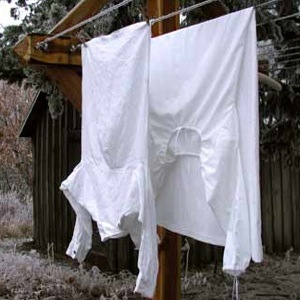 Janelle Sorensen, Healthy Child Healthy World:
Janelle Sorensen, Healthy Child Healthy World:
Last week, pediatricians in Australia called for a ban on a common ingredient in mothballs after it was linked to one baby’s death and brain damage in two others. The primary ingredient of concern is naphthalene, which causes a breakdown of red blood cells in children with a genetic condition called G6PD deficiency.
What are mothballs?
Mothballs are a pesticide product that contain either naphthalene or paradichlorobenzene as active ingredients. Both of these chemicals are toxic fumigants (which means they volatilize into the air) and must be present in high concentrations to be effective. This is the problem. Concentrations high enough to be effective for pest control can be dangerous for anyone exposed to them.
Mothballs can seriously impair indoor air quality. In fact, the odor of mothballs can be detected at a few parts per billion in the air. (One part per billion is about several drops of water in an Olympic-size swimming pool.)
What are the potential health impacts?
Symptoms of exposure to naphthalene include headache, nausea, dizziness, and difficulty breathing. Exposure to large amounts of naphthalene may damage or destroy some of your red blood cells. This condition is called hemolytic anemia. Some symptoms of hemolytic anemia are fatigue, lack of appetite, restlessness, and pale skin. Exposure to large amounts of naphthalene may also cause nausea, vomiting, diarrhea, blood in the urine, and a yellow color to the skin. Based on the results from animal studies, the Department of Health and Humans Services (DHHS) concluded that naphthalene is reasonably anticipated to be a human carcinogen.
Paradichlorobenzene exposure has been linked to nausea, vomiting, dizziness, fatigue, headaches, eye and nasal passage irritation, and dermal irritation. If a pet eats a mothball made of paradichlorobenzene, they may have vomiting, tremors, and/or abdominal pain. Paradichlorobenzene may also cause kidney and liver damage in pets. The World Health Organization (WHO) considers paradichlorobenzene possibly carcinogenic to humans based on studies with mice.
Safer Alternatives
The most important point to remember about clothes moths is that soiled cloth is much more likely to become infested.
Here are some tips from Oregon State University Extension Services:
- While cedar chips or balls smell wonderful, they do nothing to repel clothes moths.
- The best way to protect your at-risk (animal-fiber) clothing from clothes moths is by keeping moths out. To protect these garments from clothes moths, first clean all of the clothing according to the manufacturer’s specifications. Then place the clean clothing in airtight containers.
- For existing infestations of clothes moths, you must do more. Vacuum out drawers and closets using a HEPA vacuum cleaner. Vacuum all furniture and other places that provide food sources such as lint, pet hair, and human hair. Lint and hair that have been undisturbed for a long time are prime breeding grounds for clothes moths. After vacuuming, dispose of the vacuum bag promptly. To safely eliminate the moths, try a non-toxic clothes moth trap. These disposable traps use natural insect pheromones to lure moths inside, where they are caught on sticky surfaces.
- For stored clothing that is not kept in airtight containers, place the clothing in the dryer or in the sun once or twice a month to destroy larvae. Shake the clothes out or brush them before putting them back in the drawer or on the hanger. This will help dislodge remaining eggs and larvae.
And, remember to warn family and other caregivers about the risks of mothballs. In the incidents in Australia, babies were wrapped in blankets that had been stored with mothballs. Grandma might think it would be sweet to wrap her new grandbaby in a family heirloom that’s been in storage for decades – make sure it’s properly cleaned first!
If you have questions about mothballs or any pesticide-related topic, please call National Pesticide Information Center at 1-800-858-7378 (seven days per week, 6:30am-4:30pm PST), or email at npic@ace.orst.edu.
Interested in more laundry tips and recipes for safer cleaners? Sign-up for our weekly newsletter and receive an exclusive printable guide! (If you already receive our newsletter, please still sign-up here to receive the guide. You won’t get duplicate emails from us.)
Leave a Reply